Marketing Principles and McDonald's Case Study Analysis Report
VerifiedAdded on 2020/01/15
|17
|5716
|137
Report
AI Summary
This report provides a comprehensive analysis of McDonald's marketing principles, exploring various elements of the marketing process, including situation analysis, marketing strategy, marketing mix decisions, and implementation. It evaluates the benefits and costs of marketing orientation, examining micro and macro environmental factors influencing marketing decisions. The report proposes segmentation criteria, targeting strategies, and positioning strategies for McDonald's products, while also demonstrating how buying behavior affects marketing activities. Furthermore, it explains product development, distribution, and pricing strategies, integrates promotional activities, and analyzes the extended marketing mix. The report also compares marketing mixes for different consumer segments and contrasts B2B and B2C marketing, as well as international and domestic marketing, providing a holistic view of McDonald's marketing practices.
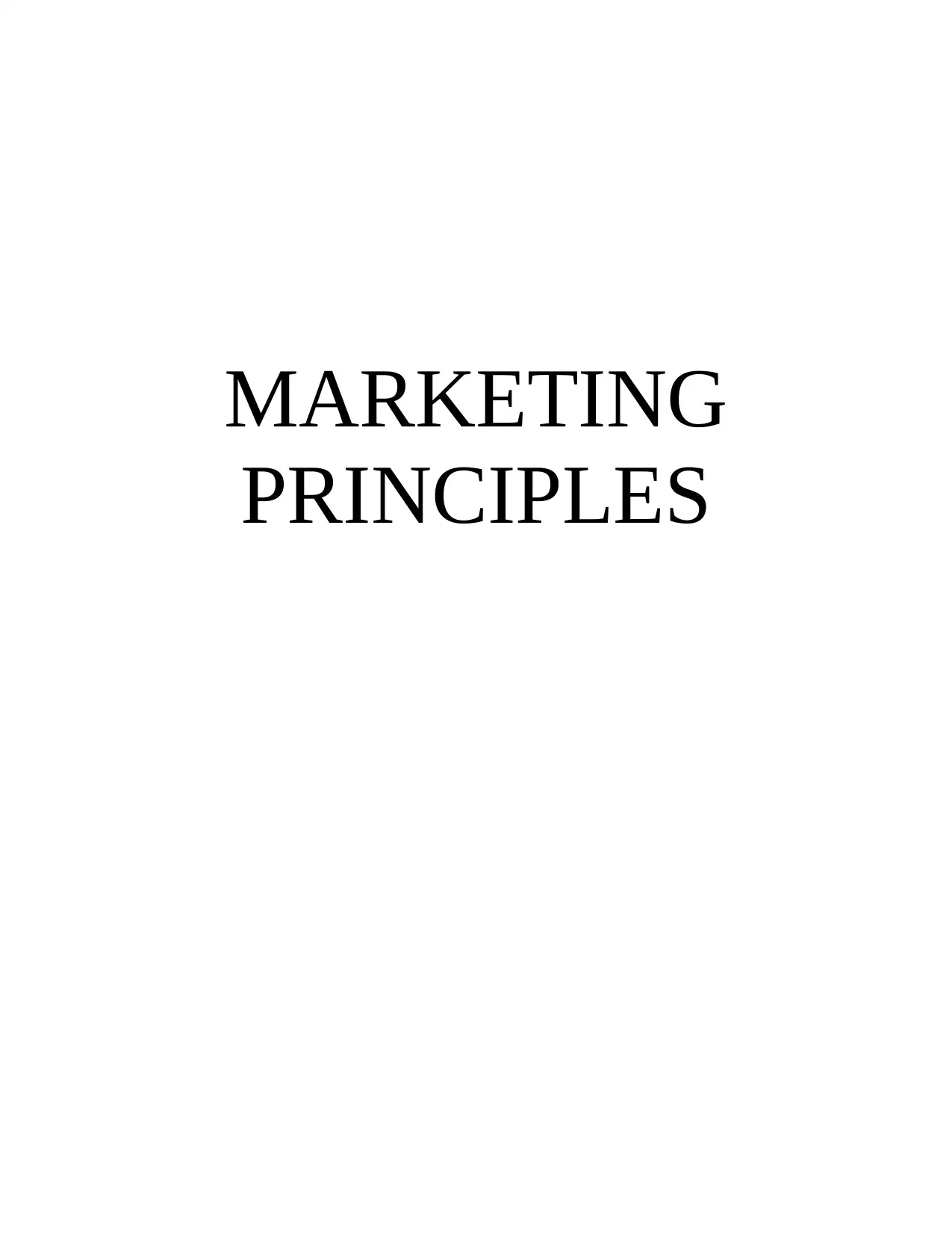
MARKETING
PRINCIPLES
PRINCIPLES
Paraphrase This Document
Need a fresh take? Get an instant paraphrase of this document with our AI Paraphraser
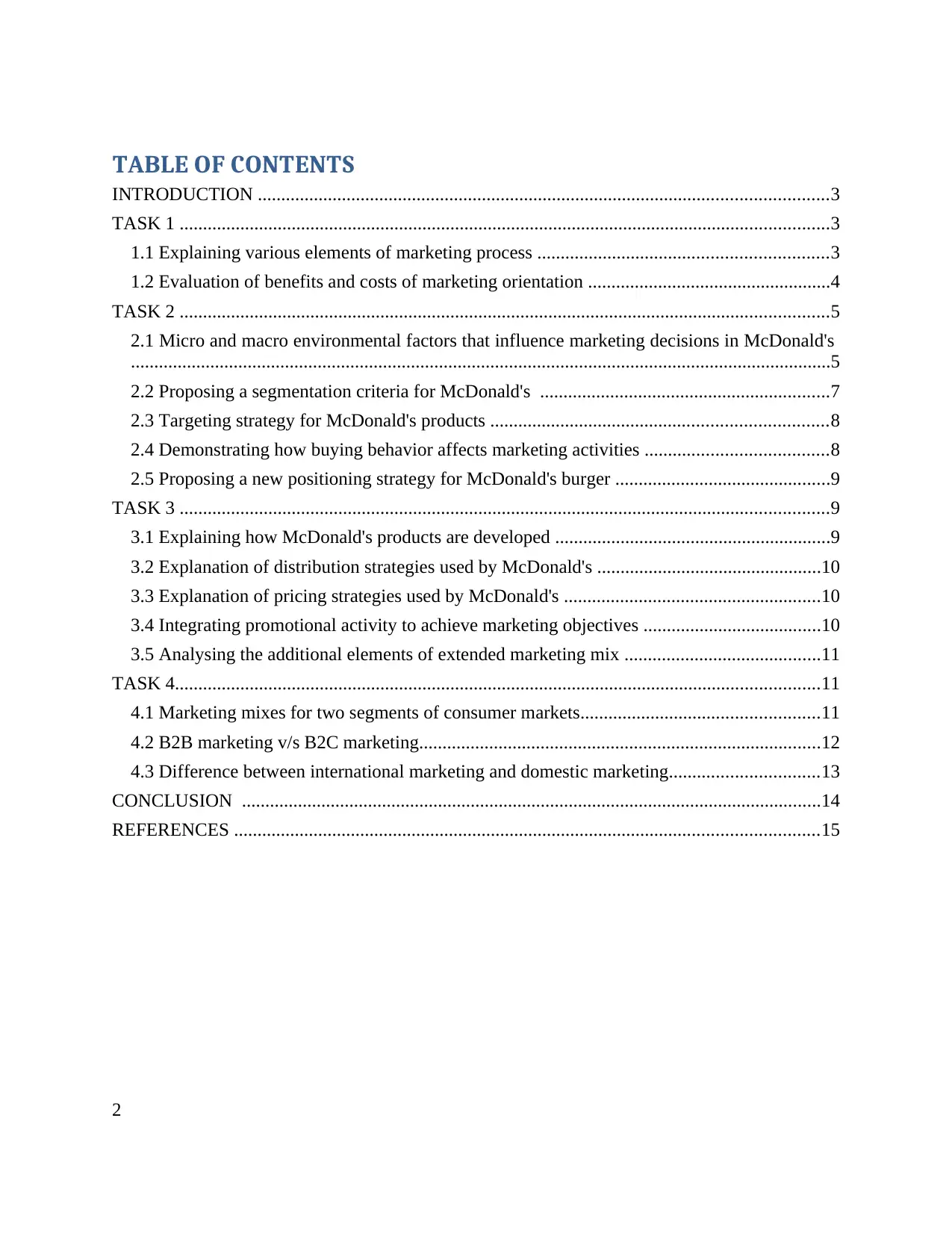
TABLE OF CONTENTS
INTRODUCTION ..........................................................................................................................3
TASK 1 ...........................................................................................................................................3
1.1 Explaining various elements of marketing process ..............................................................3
1.2 Evaluation of benefits and costs of marketing orientation ....................................................4
TASK 2 ...........................................................................................................................................5
2.1 Micro and macro environmental factors that influence marketing decisions in McDonald's
......................................................................................................................................................5
2.2 Proposing a segmentation criteria for McDonald's ..............................................................7
2.3 Targeting strategy for McDonald's products ........................................................................8
2.4 Demonstrating how buying behavior affects marketing activities .......................................8
2.5 Proposing a new positioning strategy for McDonald's burger ..............................................9
TASK 3 ...........................................................................................................................................9
3.1 Explaining how McDonald's products are developed ...........................................................9
3.2 Explanation of distribution strategies used by McDonald's ................................................10
3.3 Explanation of pricing strategies used by McDonald's .......................................................10
3.4 Integrating promotional activity to achieve marketing objectives ......................................10
3.5 Analysing the additional elements of extended marketing mix ..........................................11
TASK 4..........................................................................................................................................11
4.1 Marketing mixes for two segments of consumer markets...................................................11
4.2 B2B marketing v/s B2C marketing......................................................................................12
4.3 Difference between international marketing and domestic marketing................................13
CONCLUSION ............................................................................................................................14
REFERENCES .............................................................................................................................15
2
INTRODUCTION ..........................................................................................................................3
TASK 1 ...........................................................................................................................................3
1.1 Explaining various elements of marketing process ..............................................................3
1.2 Evaluation of benefits and costs of marketing orientation ....................................................4
TASK 2 ...........................................................................................................................................5
2.1 Micro and macro environmental factors that influence marketing decisions in McDonald's
......................................................................................................................................................5
2.2 Proposing a segmentation criteria for McDonald's ..............................................................7
2.3 Targeting strategy for McDonald's products ........................................................................8
2.4 Demonstrating how buying behavior affects marketing activities .......................................8
2.5 Proposing a new positioning strategy for McDonald's burger ..............................................9
TASK 3 ...........................................................................................................................................9
3.1 Explaining how McDonald's products are developed ...........................................................9
3.2 Explanation of distribution strategies used by McDonald's ................................................10
3.3 Explanation of pricing strategies used by McDonald's .......................................................10
3.4 Integrating promotional activity to achieve marketing objectives ......................................10
3.5 Analysing the additional elements of extended marketing mix ..........................................11
TASK 4..........................................................................................................................................11
4.1 Marketing mixes for two segments of consumer markets...................................................11
4.2 B2B marketing v/s B2C marketing......................................................................................12
4.3 Difference between international marketing and domestic marketing................................13
CONCLUSION ............................................................................................................................14
REFERENCES .............................................................................................................................15
2
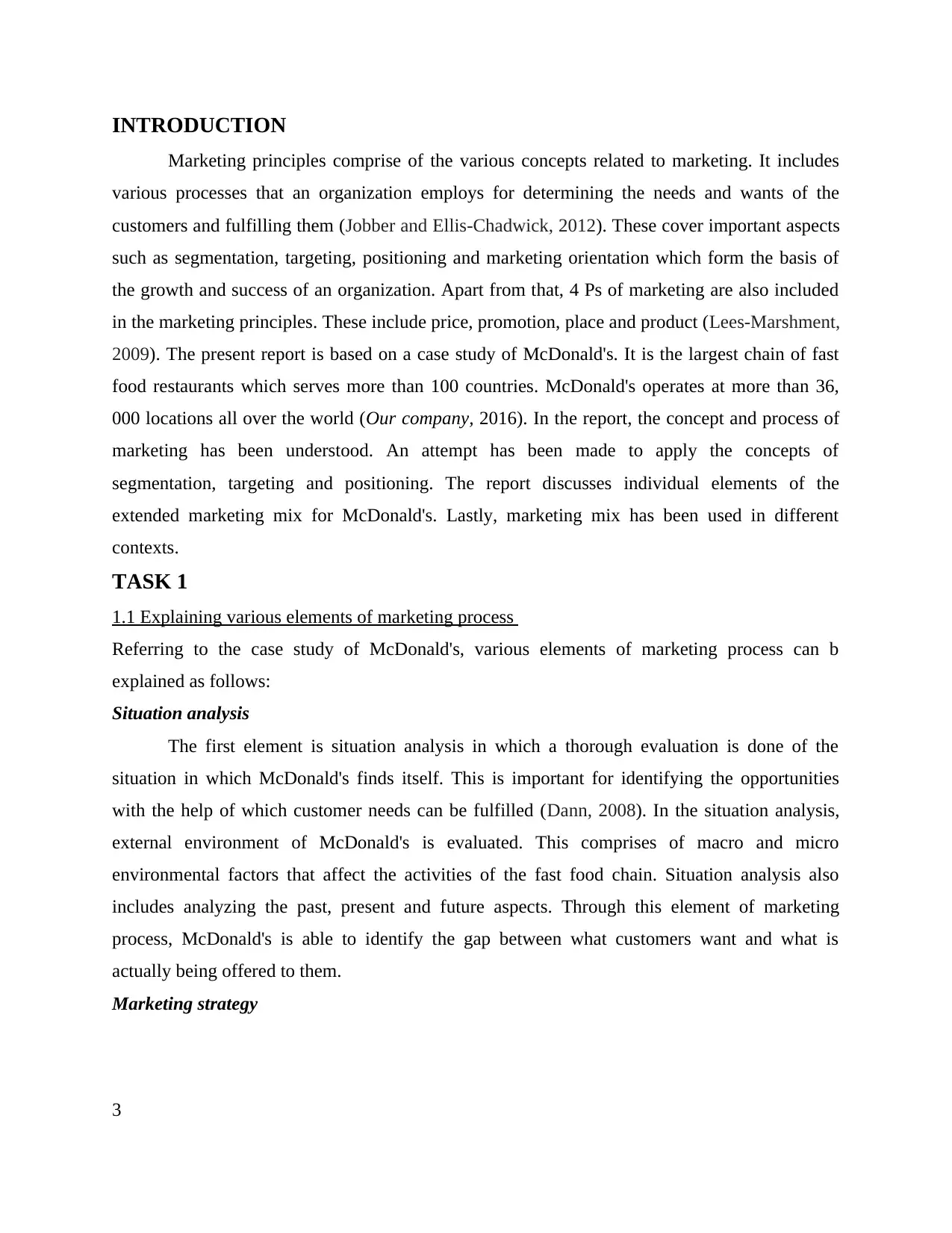
INTRODUCTION
Marketing principles comprise of the various concepts related to marketing. It includes
various processes that an organization employs for determining the needs and wants of the
customers and fulfilling them (Jobber and Ellis-Chadwick, 2012). These cover important aspects
such as segmentation, targeting, positioning and marketing orientation which form the basis of
the growth and success of an organization. Apart from that, 4 Ps of marketing are also included
in the marketing principles. These include price, promotion, place and product (Lees-Marshment,
2009). The present report is based on a case study of McDonald's. It is the largest chain of fast
food restaurants which serves more than 100 countries. McDonald's operates at more than 36,
000 locations all over the world (Our company, 2016). In the report, the concept and process of
marketing has been understood. An attempt has been made to apply the concepts of
segmentation, targeting and positioning. The report discusses individual elements of the
extended marketing mix for McDonald's. Lastly, marketing mix has been used in different
contexts.
TASK 1
1.1 Explaining various elements of marketing process
Referring to the case study of McDonald's, various elements of marketing process can b
explained as follows:
Situation analysis
The first element is situation analysis in which a thorough evaluation is done of the
situation in which McDonald's finds itself. This is important for identifying the opportunities
with the help of which customer needs can be fulfilled (Dann, 2008). In the situation analysis,
external environment of McDonald's is evaluated. This comprises of macro and micro
environmental factors that affect the activities of the fast food chain. Situation analysis also
includes analyzing the past, present and future aspects. Through this element of marketing
process, McDonald's is able to identify the gap between what customers want and what is
actually being offered to them.
Marketing strategy
3
Marketing principles comprise of the various concepts related to marketing. It includes
various processes that an organization employs for determining the needs and wants of the
customers and fulfilling them (Jobber and Ellis-Chadwick, 2012). These cover important aspects
such as segmentation, targeting, positioning and marketing orientation which form the basis of
the growth and success of an organization. Apart from that, 4 Ps of marketing are also included
in the marketing principles. These include price, promotion, place and product (Lees-Marshment,
2009). The present report is based on a case study of McDonald's. It is the largest chain of fast
food restaurants which serves more than 100 countries. McDonald's operates at more than 36,
000 locations all over the world (Our company, 2016). In the report, the concept and process of
marketing has been understood. An attempt has been made to apply the concepts of
segmentation, targeting and positioning. The report discusses individual elements of the
extended marketing mix for McDonald's. Lastly, marketing mix has been used in different
contexts.
TASK 1
1.1 Explaining various elements of marketing process
Referring to the case study of McDonald's, various elements of marketing process can b
explained as follows:
Situation analysis
The first element is situation analysis in which a thorough evaluation is done of the
situation in which McDonald's finds itself. This is important for identifying the opportunities
with the help of which customer needs can be fulfilled (Dann, 2008). In the situation analysis,
external environment of McDonald's is evaluated. This comprises of macro and micro
environmental factors that affect the activities of the fast food chain. Situation analysis also
includes analyzing the past, present and future aspects. Through this element of marketing
process, McDonald's is able to identify the gap between what customers want and what is
actually being offered to them.
Marketing strategy
3
⊘ This is a preview!⊘
Do you want full access?
Subscribe today to unlock all pages.

Trusted by 1+ million students worldwide
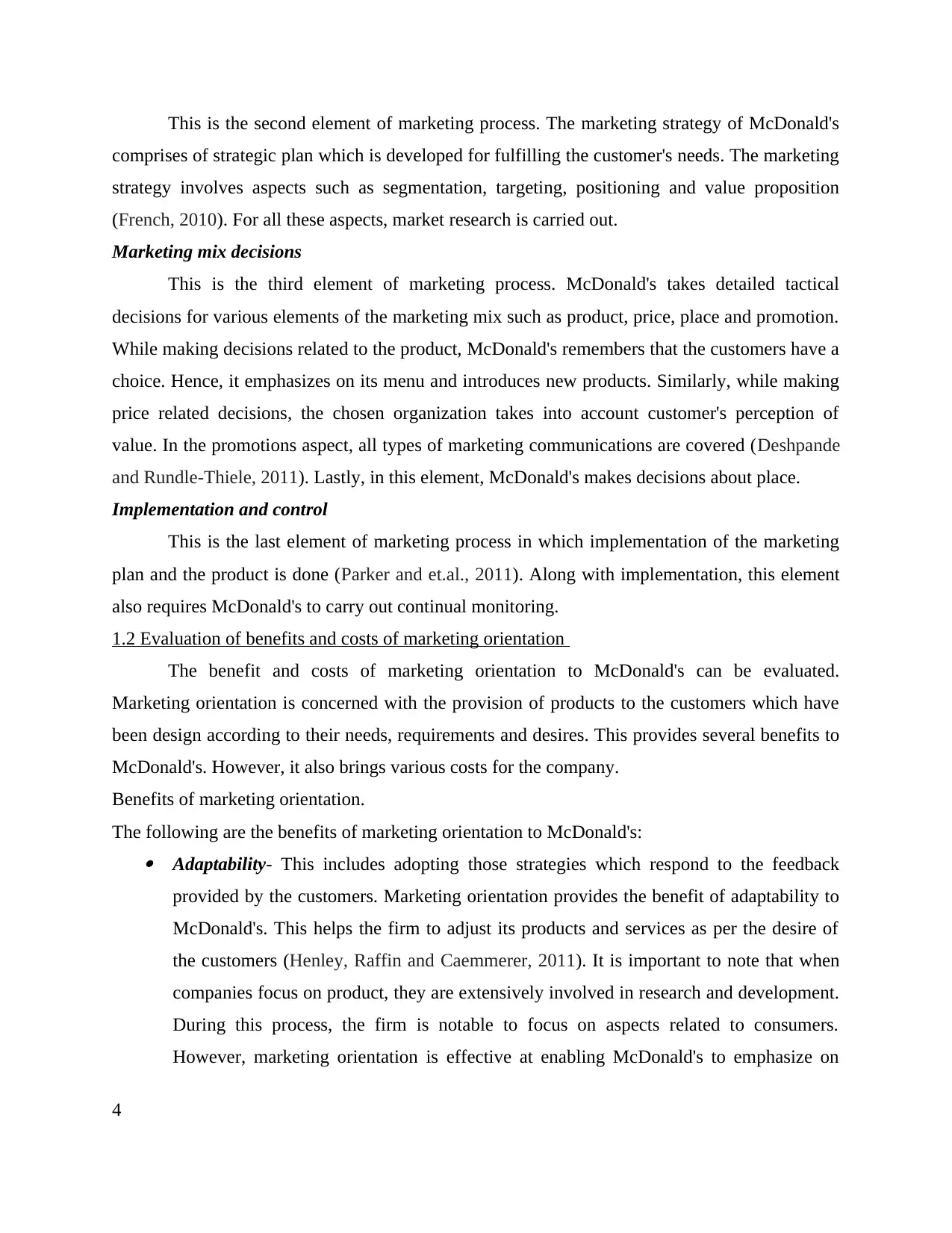
This is the second element of marketing process. The marketing strategy of McDonald's
comprises of strategic plan which is developed for fulfilling the customer's needs. The marketing
strategy involves aspects such as segmentation, targeting, positioning and value proposition
(French, 2010). For all these aspects, market research is carried out.
Marketing mix decisions
This is the third element of marketing process. McDonald's takes detailed tactical
decisions for various elements of the marketing mix such as product, price, place and promotion.
While making decisions related to the product, McDonald's remembers that the customers have a
choice. Hence, it emphasizes on its menu and introduces new products. Similarly, while making
price related decisions, the chosen organization takes into account customer's perception of
value. In the promotions aspect, all types of marketing communications are covered (Deshpande
and Rundle-Thiele, 2011). Lastly, in this element, McDonald's makes decisions about place.
Implementation and control
This is the last element of marketing process in which implementation of the marketing
plan and the product is done (Parker and et.al., 2011). Along with implementation, this element
also requires McDonald's to carry out continual monitoring.
1.2 Evaluation of benefits and costs of marketing orientation
The benefit and costs of marketing orientation to McDonald's can be evaluated.
Marketing orientation is concerned with the provision of products to the customers which have
been design according to their needs, requirements and desires. This provides several benefits to
McDonald's. However, it also brings various costs for the company.
Benefits of marketing orientation.
The following are the benefits of marketing orientation to McDonald's: Adaptability- This includes adopting those strategies which respond to the feedback
provided by the customers. Marketing orientation provides the benefit of adaptability to
McDonald's. This helps the firm to adjust its products and services as per the desire of
the customers (Henley, Raffin and Caemmerer, 2011). It is important to note that when
companies focus on product, they are extensively involved in research and development.
During this process, the firm is notable to focus on aspects related to consumers.
However, marketing orientation is effective at enabling McDonald's to emphasize on
4
comprises of strategic plan which is developed for fulfilling the customer's needs. The marketing
strategy involves aspects such as segmentation, targeting, positioning and value proposition
(French, 2010). For all these aspects, market research is carried out.
Marketing mix decisions
This is the third element of marketing process. McDonald's takes detailed tactical
decisions for various elements of the marketing mix such as product, price, place and promotion.
While making decisions related to the product, McDonald's remembers that the customers have a
choice. Hence, it emphasizes on its menu and introduces new products. Similarly, while making
price related decisions, the chosen organization takes into account customer's perception of
value. In the promotions aspect, all types of marketing communications are covered (Deshpande
and Rundle-Thiele, 2011). Lastly, in this element, McDonald's makes decisions about place.
Implementation and control
This is the last element of marketing process in which implementation of the marketing
plan and the product is done (Parker and et.al., 2011). Along with implementation, this element
also requires McDonald's to carry out continual monitoring.
1.2 Evaluation of benefits and costs of marketing orientation
The benefit and costs of marketing orientation to McDonald's can be evaluated.
Marketing orientation is concerned with the provision of products to the customers which have
been design according to their needs, requirements and desires. This provides several benefits to
McDonald's. However, it also brings various costs for the company.
Benefits of marketing orientation.
The following are the benefits of marketing orientation to McDonald's: Adaptability- This includes adopting those strategies which respond to the feedback
provided by the customers. Marketing orientation provides the benefit of adaptability to
McDonald's. This helps the firm to adjust its products and services as per the desire of
the customers (Henley, Raffin and Caemmerer, 2011). It is important to note that when
companies focus on product, they are extensively involved in research and development.
During this process, the firm is notable to focus on aspects related to consumers.
However, marketing orientation is effective at enabling McDonald's to emphasize on
4
Paraphrase This Document
Need a fresh take? Get an instant paraphrase of this document with our AI Paraphraser

research and development for producing a product which is adapted to the needs and
wants of customers.
Constant improvement- Marketing orientation provides the benefit of constant
improvement to the McDonald's. With this approach, the processes and systems of
company can be constantly improved (Hills, Hultman and Miles, 2008). This is because
marketing orientation provides a culture of experimentation. Through constant
improvement, the chosen fast food chain is able to gain competitive advantage.
Along with the benefits, there are also certain costs associated with marketing orientation to
McDonald's. These have been explained below:
High investment- Marketing orientation implies high investment for McDonald's.
This is because, this approach requires carrying out a thorough market research to
determine the needs and wants of customers (Kokemuller, 2016). McDonald's would
require a powerful market intelligence to respond accurately to the market conditions.
As databases are used for collecting, analysing and interpreting data; these require
technological infrastructure,. All these considerations bring additional costs to the
company.
Lack of predictability- Marketing orientation has another cost associated with it. With
marketing orientation, carrying out advanced planning activity for product
development become complicated (Thompson, 2008). This is because, by adopting
marketing orientation, McDonald's will only be able to respond to the perpetual
changes in the customer needs. Hence, there is lack of predictability.
TASK 2
2.1 Micro and macro environmental factors that influence marketing decisions in McDonald's
Various micro and macro environmental factors influence marketing decisions of McDonald's.
These have been explained below:
Macro environment factors
These are important to be considered to gain knowledge regarding potential opportunities and
threats for McDonald's in future.
Political factors- Political factors significantly influence the marketing decisions of
McDonald's. Political system of UK and its taxation policies affect the marketing
5
wants of customers.
Constant improvement- Marketing orientation provides the benefit of constant
improvement to the McDonald's. With this approach, the processes and systems of
company can be constantly improved (Hills, Hultman and Miles, 2008). This is because
marketing orientation provides a culture of experimentation. Through constant
improvement, the chosen fast food chain is able to gain competitive advantage.
Along with the benefits, there are also certain costs associated with marketing orientation to
McDonald's. These have been explained below:
High investment- Marketing orientation implies high investment for McDonald's.
This is because, this approach requires carrying out a thorough market research to
determine the needs and wants of customers (Kokemuller, 2016). McDonald's would
require a powerful market intelligence to respond accurately to the market conditions.
As databases are used for collecting, analysing and interpreting data; these require
technological infrastructure,. All these considerations bring additional costs to the
company.
Lack of predictability- Marketing orientation has another cost associated with it. With
marketing orientation, carrying out advanced planning activity for product
development become complicated (Thompson, 2008). This is because, by adopting
marketing orientation, McDonald's will only be able to respond to the perpetual
changes in the customer needs. Hence, there is lack of predictability.
TASK 2
2.1 Micro and macro environmental factors that influence marketing decisions in McDonald's
Various micro and macro environmental factors influence marketing decisions of McDonald's.
These have been explained below:
Macro environment factors
These are important to be considered to gain knowledge regarding potential opportunities and
threats for McDonald's in future.
Political factors- Political factors significantly influence the marketing decisions of
McDonald's. Political system of UK and its taxation policies affect the marketing
5

strategies of fast food chain organization (Sharma, Iyer and Raajpoot, 2009). Further,
presence of monopoly restrictions and trade union power have impact on marketing
decisions of McDonald's.
Economic factors- Various economic factors such as business cycles, money supply,
unemployment, consumer spending etc. influence marketing decisions of McDonald's.
If the economy of the nation is on a downturn, then the spending power of consumers
is less (Vrontis and Pavlou, 2008). In response to this, McDonald's has to promote its
products in a way so that the customers are convinced to purchase them. In contrast to
this, if the economy is experiencing a boom, the spending power of consumers
increases. Then McDonald's takes decisions accordingly.
Social factors- Social factors include demographic changes, new lifestyles, attitudes
to work, education levels, social mobility etc. which influence decision of
McDonald's. If there are changes in values of customers of UK, McDonald's has to
bring changes in its marketing mix. Its marketing decisions also changes with the
demographic changes such as ageing population (Light and Kiddon, 2009).
Technological factors- McDonald's has to take into account developments in the e-
commerce and internet. In response to this, it needs to take decisions for incorporating
these developments (Dibb, Simkin and Wilson, 2008).
Legal factors- Like all other organizations, McDonalds also operates within a
framework of laws and regulations. Laws and regulations formulated by self-
regulatory bodies such as Advertising Standards Authority and Independent
Television Commission influence the marketing decisions of McDonald's. Sales of
Goods Act and Consumer Credit Legislation also impact the chosen organization's
marketing decisions (Lin, 2011). This is because, the company has to undertake
marketing activities abiding by the laws.
Environmental factors- McDonald's has to take steps regarding the conservation of
environment. This is because, the consumers have become increasingly aware about
the impacts of organizational activities on environment (Smoyer-Tomic and et.al.,
2008).
Micro Environmental Factors
6
presence of monopoly restrictions and trade union power have impact on marketing
decisions of McDonald's.
Economic factors- Various economic factors such as business cycles, money supply,
unemployment, consumer spending etc. influence marketing decisions of McDonald's.
If the economy of the nation is on a downturn, then the spending power of consumers
is less (Vrontis and Pavlou, 2008). In response to this, McDonald's has to promote its
products in a way so that the customers are convinced to purchase them. In contrast to
this, if the economy is experiencing a boom, the spending power of consumers
increases. Then McDonald's takes decisions accordingly.
Social factors- Social factors include demographic changes, new lifestyles, attitudes
to work, education levels, social mobility etc. which influence decision of
McDonald's. If there are changes in values of customers of UK, McDonald's has to
bring changes in its marketing mix. Its marketing decisions also changes with the
demographic changes such as ageing population (Light and Kiddon, 2009).
Technological factors- McDonald's has to take into account developments in the e-
commerce and internet. In response to this, it needs to take decisions for incorporating
these developments (Dibb, Simkin and Wilson, 2008).
Legal factors- Like all other organizations, McDonalds also operates within a
framework of laws and regulations. Laws and regulations formulated by self-
regulatory bodies such as Advertising Standards Authority and Independent
Television Commission influence the marketing decisions of McDonald's. Sales of
Goods Act and Consumer Credit Legislation also impact the chosen organization's
marketing decisions (Lin, 2011). This is because, the company has to undertake
marketing activities abiding by the laws.
Environmental factors- McDonald's has to take steps regarding the conservation of
environment. This is because, the consumers have become increasingly aware about
the impacts of organizational activities on environment (Smoyer-Tomic and et.al.,
2008).
Micro Environmental Factors
6
⊘ This is a preview!⊘
Do you want full access?
Subscribe today to unlock all pages.

Trusted by 1+ million students worldwide

Competitors- This micro environmental factor comprises of the competitor strategies,
new product development and marketing activities adopted by rivals of McDonald's
(Luan and Sudhir, 2010). In response to them, McDonald's has to adopt strategies so that
it is able to retain its customers. Suppliers- Suppliers influence marketing decisions of McDonald's through their prices,
polices and operational activities. Employees- These form an important stakeholder group and influence marketing
decisions of McDonald's.
Customers- McDonald's has to take its decisions towards the direction of fulfilling the
needs of customers (Goi, 2009).
2.2 Proposing a segmentation criteria for McDonald's
Segmentation criteria can be proposed for McDonald's products in different markets.
There are different segmentation criteria such as demographic, geographic, psychographic and
behavioural segmentation (Ivy, 2008). McDonald's can segment its market by using demographic
segmentation criteria. Using this criteria, the market can be segmented on the basis of age. It can
provides products matching to the needs of customers belonging to different age groups such as
3- 12 years, 12- 19 years, above 19 years etc. People of different age have different preferences
regarding taste, flavour and texture of fast food. By segmenting the market into customers of
different age groups, McDonald's will be able to satisfy their needs in a better way.
McDonald's can also segment its market by using Psychographic segmentation. In this
segmentation criteria, the customers can be classified according to their lifestyle. Personality can
also be used as a basis for dividing customers into different segments (Chen and Xie, 2008).
Market can be segmented int customers who focus on a healthy lifestyle and those who focus
more on taste. Depending upon the personality and lifestyles, McDonald's can design its
products. Likewise, there can be two segments such as vegetarian and non vegetarian customers.
Interests and opinions can also be used for dividing the market according to psychographic
segmentation. It can provide fast food products according to the varied interests of its customers.
2.3 Targeting strategy for McDonald's products
Targeting strategy can be defined as the process of selecting potential consumers to
whom any business intends to sell its products and services. It entails for carrying out a market
7
new product development and marketing activities adopted by rivals of McDonald's
(Luan and Sudhir, 2010). In response to them, McDonald's has to adopt strategies so that
it is able to retain its customers. Suppliers- Suppliers influence marketing decisions of McDonald's through their prices,
polices and operational activities. Employees- These form an important stakeholder group and influence marketing
decisions of McDonald's.
Customers- McDonald's has to take its decisions towards the direction of fulfilling the
needs of customers (Goi, 2009).
2.2 Proposing a segmentation criteria for McDonald's
Segmentation criteria can be proposed for McDonald's products in different markets.
There are different segmentation criteria such as demographic, geographic, psychographic and
behavioural segmentation (Ivy, 2008). McDonald's can segment its market by using demographic
segmentation criteria. Using this criteria, the market can be segmented on the basis of age. It can
provides products matching to the needs of customers belonging to different age groups such as
3- 12 years, 12- 19 years, above 19 years etc. People of different age have different preferences
regarding taste, flavour and texture of fast food. By segmenting the market into customers of
different age groups, McDonald's will be able to satisfy their needs in a better way.
McDonald's can also segment its market by using Psychographic segmentation. In this
segmentation criteria, the customers can be classified according to their lifestyle. Personality can
also be used as a basis for dividing customers into different segments (Chen and Xie, 2008).
Market can be segmented int customers who focus on a healthy lifestyle and those who focus
more on taste. Depending upon the personality and lifestyles, McDonald's can design its
products. Likewise, there can be two segments such as vegetarian and non vegetarian customers.
Interests and opinions can also be used for dividing the market according to psychographic
segmentation. It can provide fast food products according to the varied interests of its customers.
2.3 Targeting strategy for McDonald's products
Targeting strategy can be defined as the process of selecting potential consumers to
whom any business intends to sell its products and services. It entails for carrying out a market
7
Paraphrase This Document
Need a fresh take? Get an instant paraphrase of this document with our AI Paraphraser
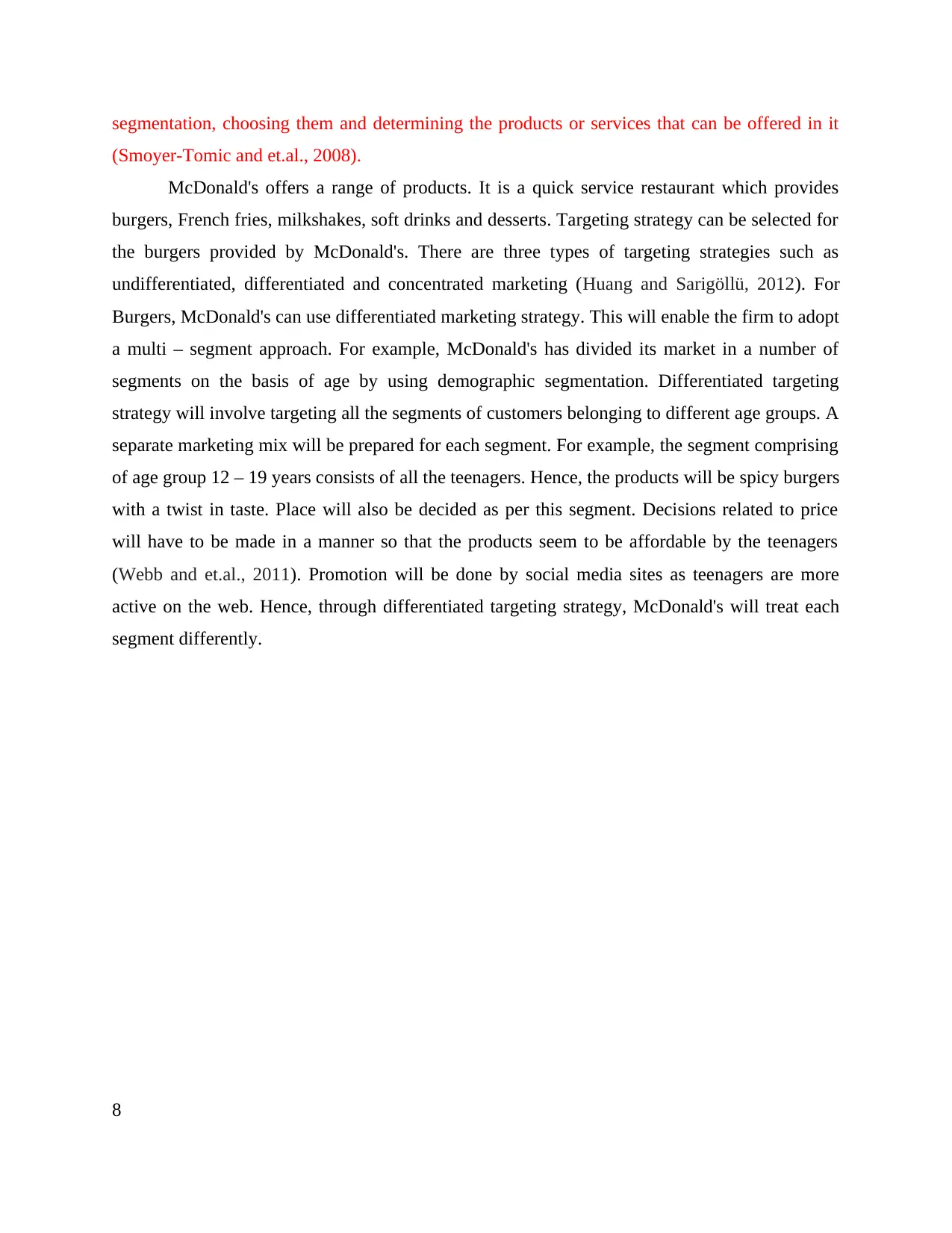
segmentation, choosing them and determining the products or services that can be offered in it
(Smoyer-Tomic and et.al., 2008).
McDonald's offers a range of products. It is a quick service restaurant which provides
burgers, French fries, milkshakes, soft drinks and desserts. Targeting strategy can be selected for
the burgers provided by McDonald's. There are three types of targeting strategies such as
undifferentiated, differentiated and concentrated marketing (Huang and Sarigöllü, 2012). For
Burgers, McDonald's can use differentiated marketing strategy. This will enable the firm to adopt
a multi – segment approach. For example, McDonald's has divided its market in a number of
segments on the basis of age by using demographic segmentation. Differentiated targeting
strategy will involve targeting all the segments of customers belonging to different age groups. A
separate marketing mix will be prepared for each segment. For example, the segment comprising
of age group 12 – 19 years consists of all the teenagers. Hence, the products will be spicy burgers
with a twist in taste. Place will also be decided as per this segment. Decisions related to price
will have to be made in a manner so that the products seem to be affordable by the teenagers
(Webb and et.al., 2011). Promotion will be done by social media sites as teenagers are more
active on the web. Hence, through differentiated targeting strategy, McDonald's will treat each
segment differently.
8
(Smoyer-Tomic and et.al., 2008).
McDonald's offers a range of products. It is a quick service restaurant which provides
burgers, French fries, milkshakes, soft drinks and desserts. Targeting strategy can be selected for
the burgers provided by McDonald's. There are three types of targeting strategies such as
undifferentiated, differentiated and concentrated marketing (Huang and Sarigöllü, 2012). For
Burgers, McDonald's can use differentiated marketing strategy. This will enable the firm to adopt
a multi – segment approach. For example, McDonald's has divided its market in a number of
segments on the basis of age by using demographic segmentation. Differentiated targeting
strategy will involve targeting all the segments of customers belonging to different age groups. A
separate marketing mix will be prepared for each segment. For example, the segment comprising
of age group 12 – 19 years consists of all the teenagers. Hence, the products will be spicy burgers
with a twist in taste. Place will also be decided as per this segment. Decisions related to price
will have to be made in a manner so that the products seem to be affordable by the teenagers
(Webb and et.al., 2011). Promotion will be done by social media sites as teenagers are more
active on the web. Hence, through differentiated targeting strategy, McDonald's will treat each
segment differently.
8

2.4 Demonstrating how buying behavior affects marketing activities
Figure 1 Buying behaviour process
Buyer behaviour affects marketing activities in different buying situations. This requires
the marketing managers of McDonald's to consider various buying situations. For example, there
can be a buying situation known as straight re – buy. This is the easiest buying situation in which
a customer purchases standard products from a familiar supplier (Srinivasan and Hanssens,
2009). In this situation, the buyer behaviour is intended towards purchasing the product which
the customer has been enjoying for a while and is familiar with it. Hence, the marketing
activities of McDonald's will be aimed at gaining customer confidence and trust by providing the
original fast food items with their familiar taste. There can be another buying situation known as
new buy. For example, McDonald's has introduced a new burger or fast food item and consumer
is purchasing it for the first time at its outlet. Here, the marketing managers of McDonald's will
have to consider this situation. It affects marketing activities of the chosen fast food chain. This
is because, McDonald's will be required to provide adequate information about the product
through its promotional activities so that consumer is attracted towards the product (Jobber and
Ellis-Chadwick, 2012).
9
Figure 1 Buying behaviour process
Buyer behaviour affects marketing activities in different buying situations. This requires
the marketing managers of McDonald's to consider various buying situations. For example, there
can be a buying situation known as straight re – buy. This is the easiest buying situation in which
a customer purchases standard products from a familiar supplier (Srinivasan and Hanssens,
2009). In this situation, the buyer behaviour is intended towards purchasing the product which
the customer has been enjoying for a while and is familiar with it. Hence, the marketing
activities of McDonald's will be aimed at gaining customer confidence and trust by providing the
original fast food items with their familiar taste. There can be another buying situation known as
new buy. For example, McDonald's has introduced a new burger or fast food item and consumer
is purchasing it for the first time at its outlet. Here, the marketing managers of McDonald's will
have to consider this situation. It affects marketing activities of the chosen fast food chain. This
is because, McDonald's will be required to provide adequate information about the product
through its promotional activities so that consumer is attracted towards the product (Jobber and
Ellis-Chadwick, 2012).
9
⊘ This is a preview!⊘
Do you want full access?
Subscribe today to unlock all pages.

Trusted by 1+ million students worldwide
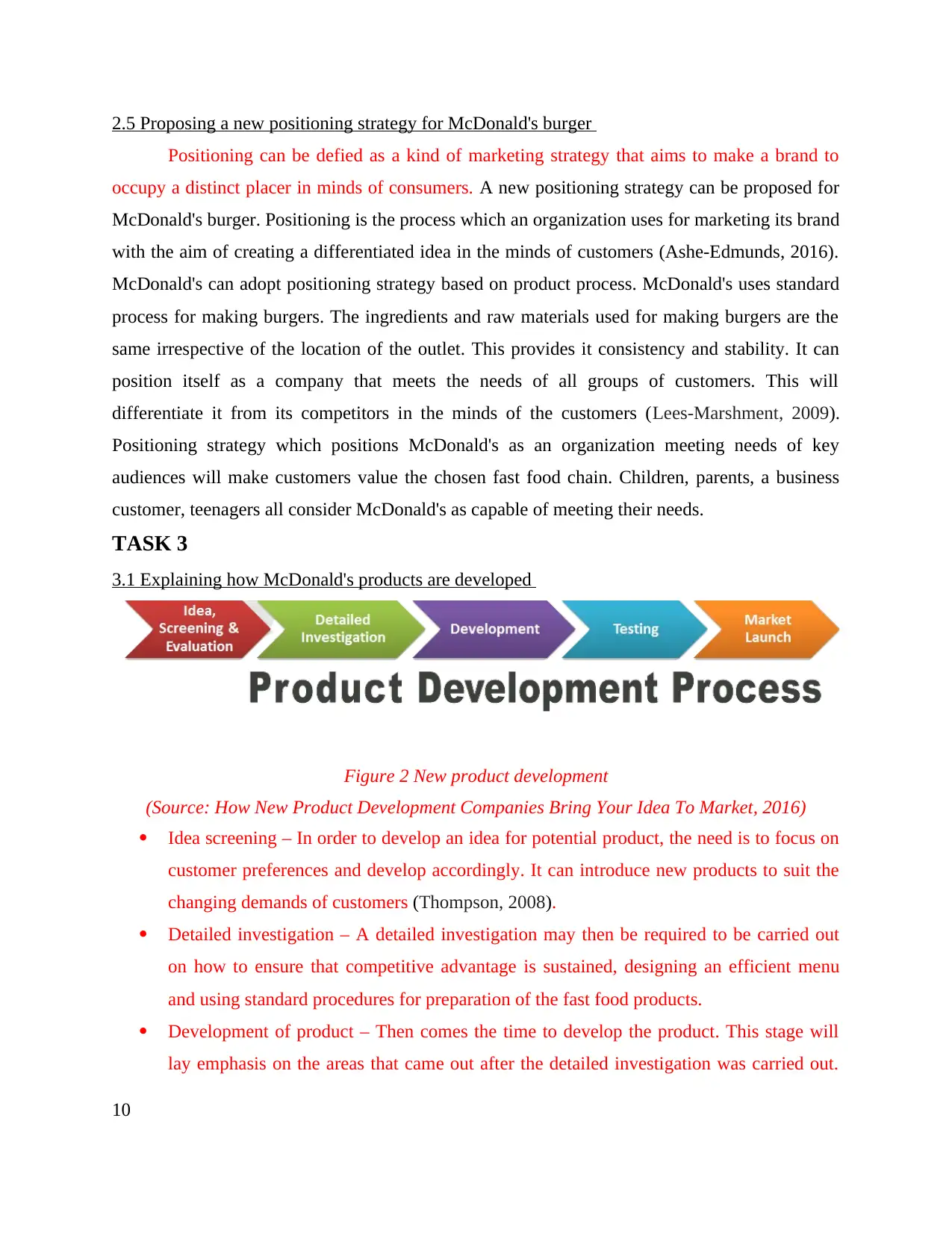
2.5 Proposing a new positioning strategy for McDonald's burger
Positioning can be defied as a kind of marketing strategy that aims to make a brand to
occupy a distinct placer in minds of consumers. A new positioning strategy can be proposed for
McDonald's burger. Positioning is the process which an organization uses for marketing its brand
with the aim of creating a differentiated idea in the minds of customers (Ashe-Edmunds, 2016).
McDonald's can adopt positioning strategy based on product process. McDonald's uses standard
process for making burgers. The ingredients and raw materials used for making burgers are the
same irrespective of the location of the outlet. This provides it consistency and stability. It can
position itself as a company that meets the needs of all groups of customers. This will
differentiate it from its competitors in the minds of the customers (Lees-Marshment, 2009).
Positioning strategy which positions McDonald's as an organization meeting needs of key
audiences will make customers value the chosen fast food chain. Children, parents, a business
customer, teenagers all consider McDonald's as capable of meeting their needs.
TASK 3
3.1 Explaining how McDonald's products are developed
Figure 2 New product development
(Source: How New Product Development Companies Bring Your Idea To Market, 2016)
Idea screening – In order to develop an idea for potential product, the need is to focus on
customer preferences and develop accordingly. It can introduce new products to suit the
changing demands of customers (Thompson, 2008).
Detailed investigation – A detailed investigation may then be required to be carried out
on how to ensure that competitive advantage is sustained, designing an efficient menu
and using standard procedures for preparation of the fast food products.
Development of product – Then comes the time to develop the product. This stage will
lay emphasis on the areas that came out after the detailed investigation was carried out.
10
Positioning can be defied as a kind of marketing strategy that aims to make a brand to
occupy a distinct placer in minds of consumers. A new positioning strategy can be proposed for
McDonald's burger. Positioning is the process which an organization uses for marketing its brand
with the aim of creating a differentiated idea in the minds of customers (Ashe-Edmunds, 2016).
McDonald's can adopt positioning strategy based on product process. McDonald's uses standard
process for making burgers. The ingredients and raw materials used for making burgers are the
same irrespective of the location of the outlet. This provides it consistency and stability. It can
position itself as a company that meets the needs of all groups of customers. This will
differentiate it from its competitors in the minds of the customers (Lees-Marshment, 2009).
Positioning strategy which positions McDonald's as an organization meeting needs of key
audiences will make customers value the chosen fast food chain. Children, parents, a business
customer, teenagers all consider McDonald's as capable of meeting their needs.
TASK 3
3.1 Explaining how McDonald's products are developed
Figure 2 New product development
(Source: How New Product Development Companies Bring Your Idea To Market, 2016)
Idea screening – In order to develop an idea for potential product, the need is to focus on
customer preferences and develop accordingly. It can introduce new products to suit the
changing demands of customers (Thompson, 2008).
Detailed investigation – A detailed investigation may then be required to be carried out
on how to ensure that competitive advantage is sustained, designing an efficient menu
and using standard procedures for preparation of the fast food products.
Development of product – Then comes the time to develop the product. This stage will
lay emphasis on the areas that came out after the detailed investigation was carried out.
10
Paraphrase This Document
Need a fresh take? Get an instant paraphrase of this document with our AI Paraphraser
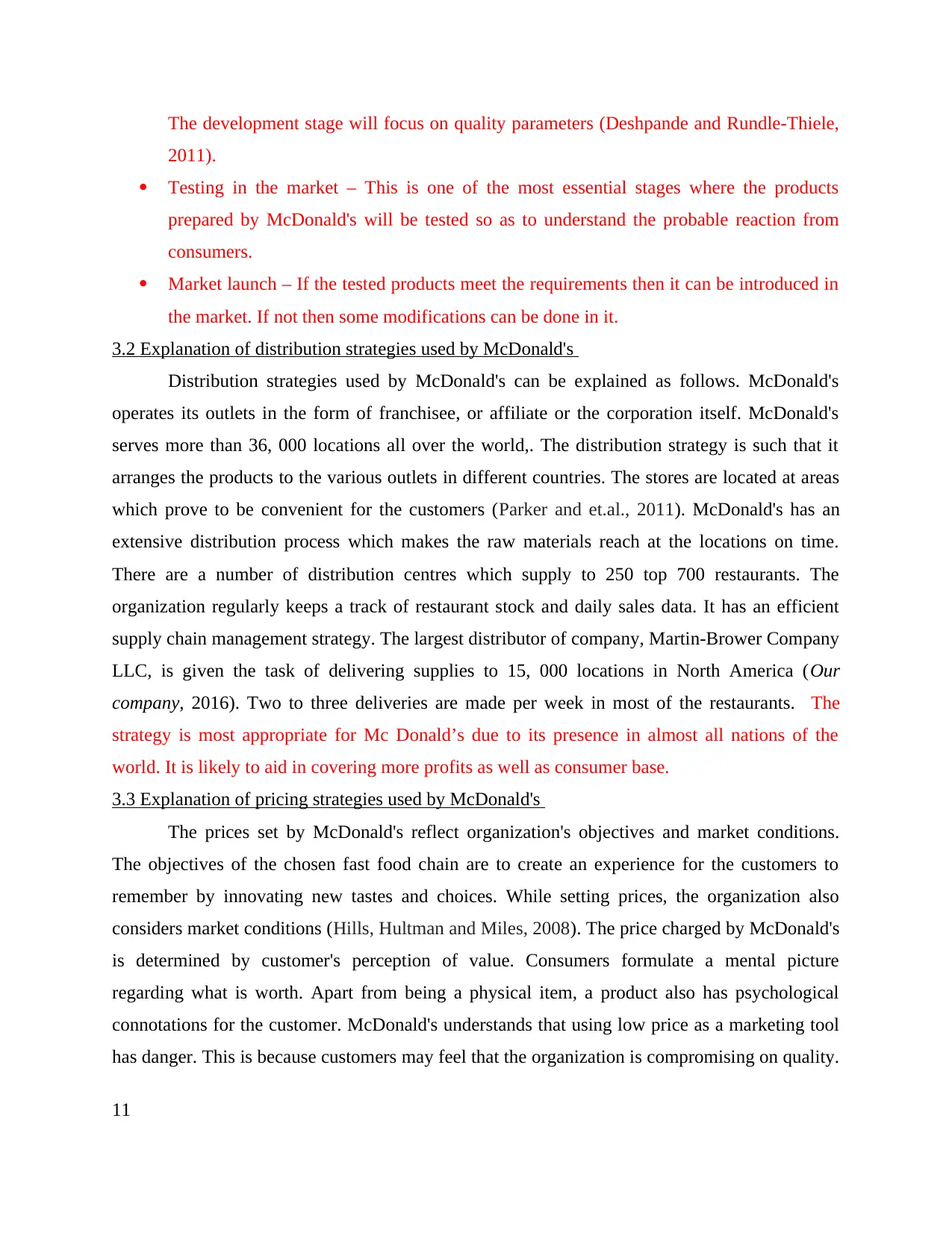
The development stage will focus on quality parameters (Deshpande and Rundle-Thiele,
2011).
Testing in the market – This is one of the most essential stages where the products
prepared by McDonald's will be tested so as to understand the probable reaction from
consumers.
Market launch – If the tested products meet the requirements then it can be introduced in
the market. If not then some modifications can be done in it.
3.2 Explanation of distribution strategies used by McDonald's
Distribution strategies used by McDonald's can be explained as follows. McDonald's
operates its outlets in the form of franchisee, or affiliate or the corporation itself. McDonald's
serves more than 36, 000 locations all over the world,. The distribution strategy is such that it
arranges the products to the various outlets in different countries. The stores are located at areas
which prove to be convenient for the customers (Parker and et.al., 2011). McDonald's has an
extensive distribution process which makes the raw materials reach at the locations on time.
There are a number of distribution centres which supply to 250 top 700 restaurants. The
organization regularly keeps a track of restaurant stock and daily sales data. It has an efficient
supply chain management strategy. The largest distributor of company, Martin-Brower Company
LLC, is given the task of delivering supplies to 15, 000 locations in North America (Our
company, 2016). Two to three deliveries are made per week in most of the restaurants. The
strategy is most appropriate for Mc Donald’s due to its presence in almost all nations of the
world. It is likely to aid in covering more profits as well as consumer base.
3.3 Explanation of pricing strategies used by McDonald's
The prices set by McDonald's reflect organization's objectives and market conditions.
The objectives of the chosen fast food chain are to create an experience for the customers to
remember by innovating new tastes and choices. While setting prices, the organization also
considers market conditions (Hills, Hultman and Miles, 2008). The price charged by McDonald's
is determined by customer's perception of value. Consumers formulate a mental picture
regarding what is worth. Apart from being a physical item, a product also has psychological
connotations for the customer. McDonald's understands that using low price as a marketing tool
has danger. This is because customers may feel that the organization is compromising on quality.
11
2011).
Testing in the market – This is one of the most essential stages where the products
prepared by McDonald's will be tested so as to understand the probable reaction from
consumers.
Market launch – If the tested products meet the requirements then it can be introduced in
the market. If not then some modifications can be done in it.
3.2 Explanation of distribution strategies used by McDonald's
Distribution strategies used by McDonald's can be explained as follows. McDonald's
operates its outlets in the form of franchisee, or affiliate or the corporation itself. McDonald's
serves more than 36, 000 locations all over the world,. The distribution strategy is such that it
arranges the products to the various outlets in different countries. The stores are located at areas
which prove to be convenient for the customers (Parker and et.al., 2011). McDonald's has an
extensive distribution process which makes the raw materials reach at the locations on time.
There are a number of distribution centres which supply to 250 top 700 restaurants. The
organization regularly keeps a track of restaurant stock and daily sales data. It has an efficient
supply chain management strategy. The largest distributor of company, Martin-Brower Company
LLC, is given the task of delivering supplies to 15, 000 locations in North America (Our
company, 2016). Two to three deliveries are made per week in most of the restaurants. The
strategy is most appropriate for Mc Donald’s due to its presence in almost all nations of the
world. It is likely to aid in covering more profits as well as consumer base.
3.3 Explanation of pricing strategies used by McDonald's
The prices set by McDonald's reflect organization's objectives and market conditions.
The objectives of the chosen fast food chain are to create an experience for the customers to
remember by innovating new tastes and choices. While setting prices, the organization also
considers market conditions (Hills, Hultman and Miles, 2008). The price charged by McDonald's
is determined by customer's perception of value. Consumers formulate a mental picture
regarding what is worth. Apart from being a physical item, a product also has psychological
connotations for the customer. McDonald's understands that using low price as a marketing tool
has danger. This is because customers may feel that the organization is compromising on quality.
11

Moreover, if the prices are reduced, then competitors may match it thus resulting in no extra
demand (Sharma, Iyer and Raajpoot, 2009). Hence, McDonald's sets its prices according to the
market conditions and objectives. For this, it makes use of penetration pricing strategy.
3.4 Integrating promotional activity to achieve marketing objectives
McDonald's uses integrated promotional activity for achieving marketing objectives. The
promotions aspect of organization covers all types of marketing communication (Vrontis and
Pavlou, 2008).
Personal selling - With the help of this approach, McDonald's are to reach greater number
of customers and make them aware about the new products of the fast food chain.
Sales promotion – This is done by launching of loyalty schemes, vouchers etc so as to
ensure that consumers are attracted to product offering of Mc Donalds (Thompson,
2008).
Public relations - McDonald's uses Public relations to make provide them detailed
information about its products.
3.5 Analysing the additional elements of extended marketing mix
The additional elements of extended marketing mix for McDonald's have been analysed below: People- At McDonald's, the employees have to wear a standard uniform. The chosen
organization lays emphasis on providing friendly and prompt service to its customers
(Light and Kiddon, 2009). In order to develop the people element of Mc Donmalds, focus
is further given on making the employees developed by undertaking there training
sessions. These can be related to handling clients, communication and presentation skills
among others. Process- McDonald's keep its food manufacturing process transparent. The customers
can see the whole process. It uses standard processes for manufacturing food items.
Hence, this provides consists taste to the customers irrespective of the location of the
outlet. It further focuses on fast billing system so as to ensure that consumers do not have
to face any waiting period.
Physical evidence- All the outlets of McDonald's focus on providing clean and hygienic
interiors. McDonald's also makes its outlets attractive and relaxing. Proper decorum is
12
demand (Sharma, Iyer and Raajpoot, 2009). Hence, McDonald's sets its prices according to the
market conditions and objectives. For this, it makes use of penetration pricing strategy.
3.4 Integrating promotional activity to achieve marketing objectives
McDonald's uses integrated promotional activity for achieving marketing objectives. The
promotions aspect of organization covers all types of marketing communication (Vrontis and
Pavlou, 2008).
Personal selling - With the help of this approach, McDonald's are to reach greater number
of customers and make them aware about the new products of the fast food chain.
Sales promotion – This is done by launching of loyalty schemes, vouchers etc so as to
ensure that consumers are attracted to product offering of Mc Donalds (Thompson,
2008).
Public relations - McDonald's uses Public relations to make provide them detailed
information about its products.
3.5 Analysing the additional elements of extended marketing mix
The additional elements of extended marketing mix for McDonald's have been analysed below: People- At McDonald's, the employees have to wear a standard uniform. The chosen
organization lays emphasis on providing friendly and prompt service to its customers
(Light and Kiddon, 2009). In order to develop the people element of Mc Donmalds, focus
is further given on making the employees developed by undertaking there training
sessions. These can be related to handling clients, communication and presentation skills
among others. Process- McDonald's keep its food manufacturing process transparent. The customers
can see the whole process. It uses standard processes for manufacturing food items.
Hence, this provides consists taste to the customers irrespective of the location of the
outlet. It further focuses on fast billing system so as to ensure that consumers do not have
to face any waiting period.
Physical evidence- All the outlets of McDonald's focus on providing clean and hygienic
interiors. McDonald's also makes its outlets attractive and relaxing. Proper decorum is
12
⊘ This is a preview!⊘
Do you want full access?
Subscribe today to unlock all pages.

Trusted by 1+ million students worldwide
1 out of 17
Related Documents
Your All-in-One AI-Powered Toolkit for Academic Success.
+13062052269
info@desklib.com
Available 24*7 on WhatsApp / Email
![[object Object]](/_next/static/media/star-bottom.7253800d.svg)
Unlock your academic potential
Copyright © 2020–2025 A2Z Services. All Rights Reserved. Developed and managed by ZUCOL.





